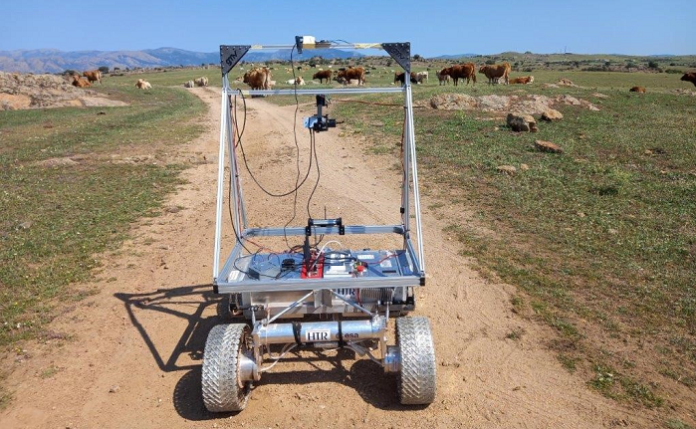
During the first half of July the multinational technology company GMV is conducting field tests as part of RAPID (Robust and Semi-Autonomous Platform for Increased Distances), a space robotics project run by the European Space Agency (ESA). Dry runs are being carried out in open fields in the town of Colmenar Viejo, Madrid.
With more than 3,000 employees worldwide and its headquarters in Madrid (Spain), GMV develops systems and technology for various space applications. One of these systems includes robotic systems for planetary exploration (such as the Moon or Mars) and all the associated elements, including mobility, guidance/navigation systems, route planning through rugged terrains, and systems capable of carrying out its functions completely autonomously.
Space robotics has been identified by major European and global space players as a critical technology for the future of the industry. Both the European Space Agency (ESA) and the European Commission (EC) are funding multiple developments related to space robotics technologies, thanks to their potential reuse in complex terrestrial environments such as search and rescue, mining, nuclear power plants, and more.
In this context, as part of the RAPID project led by GMV for the European Space Agency (ESA), GMV is currently designing and developing a cutting-edge robotic platform, an autonomous rover capable of safely traversing lunar areas at an average speed of 1.1 m/s, a speed never before achieved on the surface of a distant planet by an autonomous robot, using a guidance, navigation, and control (GNC) system based on visual navigation, i.e. on images generated/acquired by cameras installed on the rover.
The Moon has been and continues to be the next step in human exploration. Water, along with other volatile and lunar materials such as regolith, metals, and rare earth elements (REE), present potential resources that can sustain human and robotic exploration sustainably on the Moon, the Solar System, and beyond. The lunar poles, in particular, are of great interest for exploration but present harsh environmental conditions with very low temperatures (below 30K/-243 degrees Celsius) and challenging lighting conditions.
In the project’s initial phase, the mission’s terrain characteristics were defined, including planned traverse distances, types of obstacles, and the functional requirements of the components, as well as their operational and testing requirements.
Subsequently, GMV designed the RAPID mobile platform to meet the proposed requirements, particularly in terms of speed. This required improvements in all the subsystems involved: suspension, wheel characteristics, motors, power systems, as well as conducting several simulations of the rover’s interaction with the ground to ensure it maintains contact, avoids slippage, and prevents tipping over during traverses.
Additionally, GMV has developed a semi-autonomous guidance, navigation, and control (GNC) subsystem with the main objective of achieving continuous driving, going beyond the current “stop-and-go” approach and avoiding stops during traverses. The main goal of this task has been to ensure that the GNC can drive the rover at the required speed, enabling much faster control cycles than traditional rovers. The project includes a control center to command the rover using different levels of autonomy, ranging from teleoperation to sending autonomous commands (e.g., autonomously going to a specific point).
Currently, GMV is conducting integration, preliminary, and field tests with the demonstrator in open fields, collecting performance parameters and test results. Rocks with specific mineral types, unique topographies, traces of moisture, and ancient streambeds are the research objectives for these tests, which will train it for future planetary exploration missions.
The initial RAPID tests are taking place in Dehesa de Navalvillar, Colmenar Viejo, Madrid, following all the instructions to ensure proper use and minimize impact in one of the natural environments most appreciated by the residents of the Sierra de Madrid for a dry run.
Starting on July 17, the RAPID robotic platform will be tested in Cabanillas, Navarre, an area with topographical conditions similar to the landscapes the rover would encounter on the Moon and Mars. In addition to the RAPID project, GMV is leading other space robotics projects as part of the ESA, such as the European Moon Rover System, or the European Commission’s PERASPERA, which involves the development of the operating system for space robot control (ESROCOS project) and autonomy or artificial intelligence systems (ERGO project).



















